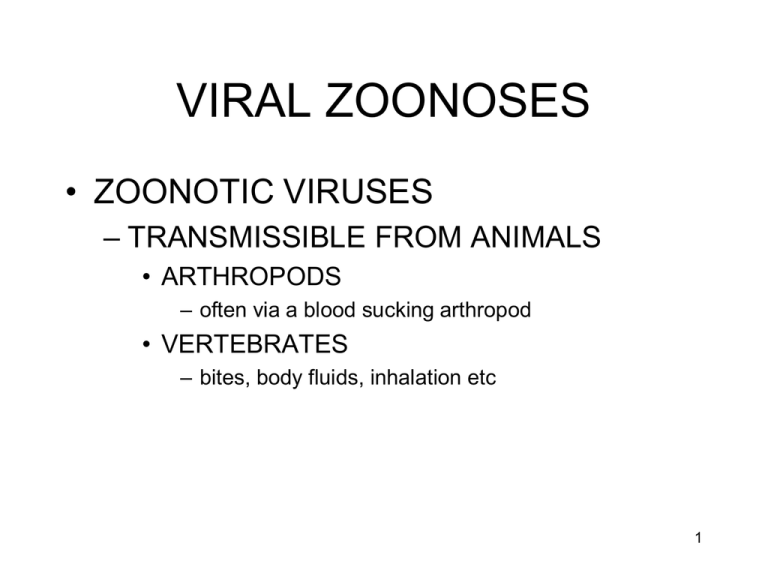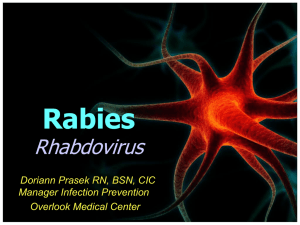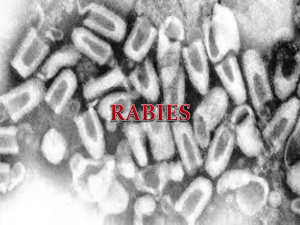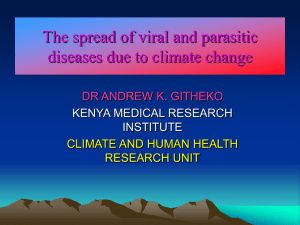VIRAL ZOONOSES
advertisement

VIRAL ZOONOSES • ZOONOTIC VIRUSES – TRANSMISSIBLE FROM ANIMALS • ARTHROPODS – often via a blood sucking arthropod • VERTEBRATES – bites, body fluids, inhalation etc 1 VIRAL ZOONOSES PART I ARTHROPOD BORNE 2 transmission • arthropod vectors (blood sucking) • Many arboviral diseases world wide (hundreds) 3 VIGILANCE 4 • ARBOVIRUSES – FEBRILE DISEASES – ENCEPHALITIS – HEMORRHAGIC FEVERS 5 ARBOVIRUSES FAMILY ENVELOPE SYMMETRY GENOME yes icosahedral ssRNA (+ve) yes helical ssRNA (-ve) segmented no icosahedral dsRNA, segmented 6 Birds Mammals Humans 7 ARTHROPOD • Habitat • Diurnal activity • Preferred host • Annual activity • Overwintering ability • Transovarial transmission VERTEBRATE • Migratory activity • Persistence of viremia • Clinical consequences • Reservoir ? • Dead end host? 8 PREVENTION • • • • • SURVEILLANCE VECTOR CONTROL REPELLENTS CLOTHING TIMING OF ACTIVITY (OR CANCELLATION) • VACCINE 9 SYLVATIC (JUNGLE) CYCLE vertebrate arthropod arthropod vertebrate human 10 URBAN CYCLE human arthropod arthropod human human cycle note: viruses which have a human cycle may also have a sylvatic/jungle cycle 11 OUTBREAKS • TEND TO BE SUMMER/EARLY FALL • SPORADIC • UNPREDICTABLE 12 ARBOVIRAL DISEASE • MANY DIFFERENT ARBOVIRUSES CAUSE DISEASE • OFTEN SUB-CLINICAL 13 ARBOVIRAL DISEASE • INITIAL VIRAL REPLICATION – endothelial cells – macrophages/monocyte lineage • INTERFERON (RNA VIRUSES) – headache, fever, myalgia • VIREMIA – spread to target tissues, depending on tropism of virus 14 RECOVERY • INTERFERON • CELL-MEDIATED IMMUNITY • ANTIBODY MAY PLAY A ROLE IN PREVENTING SPREAD DURING VIREMIC PHASE 15 DIAGNOSIS – Immunological techniques – RT-PCR for viral RNA 16 RESISTANCE • IgG 17 ARBOVIRUSES – ENCEPHALITIS FAMILY DISTRIBUTION FLAVIVIRIDAE West Nile virus encephalitis North America, parts of Europe, parts of Africa St Louis encephalitis North America TOGAVIRIDAE Eastern equine encephalitis East US, Canada Western equine encephalitis West US, Canada, Mexico, Brazil BUNYAVIRIDAE California serogroup (La Crosse etc) North America 18 ARBOVIRUS ENCEPHALITIS • SPORADIC • LOW % INFECTIONS -> CLINICAL CASES • NOT ALL CASES -> MAJOR DISEASE • PROBABLY UNDERDIAGNOSED 19 WEST NILE VIRUS • Reservoir: birds • Vector: mosquito • human, horse – dead end hosts flavivirus 20 http://www.cdc.gov/ncidod/dvbid/westnile/cycle.htm 3 50 1999 2000 2003 52 1999 2 2000 2003 54 2000 1999 2001 2003 50 2000 2002 200 2001 1999 51 2002 20 2003 51 2003 54 2000 50 53 2003 52 52 2000 West Nile virus 2003 flavivirus 2 21 Final 2008 West Nile Virus activity in the United States West Nile virus flavivirus 22 WEST NILE VIRUS • Symptoms: – Fever – Meningitis – Encephalitis More rarely: – Acute flaccid paralysis • West Nile polio-like paralysis – poliomyelitis - inflammation spinal cord flavivirus 23 http://www.cdc.gov/ncidod/dvbid/westnile/cycle.htm West Nile Virus For every ~150 people infected – ~30 mild symptoms • mild fever, headache, body ache, maybe rash – may never see physician, even if do, may not be diagnosed – ~1 severe illness • e.g. encephalitis, meningitis, high fever, stiff neck, stupor, disorientation, coma, tremors, convulsions, muscle weakness – frequency of flaccid paralysis unknown, but much less than frequency of encephalitis flavivirus 24 WEST NILE VIRUS Case fatality ratio: • Seen in all age groups but higher in the elderly – the majority of cases of neuroinvasive diseases and fatalities are over 50 yrs age • Transplant recipients may be at higher risk – increased incidence of clinical disease – increased risk of severe disease flavivirus 25 26 http://www.cdc.gov/ncidod/dvbid/westnile/resources/wnv_transplant%20brochure6_12_07.pdf WEST NILE VIRUS transmission: • Mosquito (vast majority of cases) • Blood transfusion (blood supply is now screened) • Organ donation flavivirus 27 flavivirus Reported Human WNV Disease Cases, US 1999 62 2000 21 2001 66 2002 4156 2003 9862 2004 2539 2005 3000 2006 4269 2007 3630 2008 1338 2009 515 (as of 10-20-09) 2008 Case Fatality Rate = 44/1356 = 3.2% 28 ST. LOUIS ENCEPHALITIS • Second commonest mosquito borne disease in US • Reservoir: birds – Man is usually a dead end host • • • • • Vector: mosquito <1% infections clinical Elderly at higher risk CFR 3-25% ~100 cases/year av. flavivirus 29 EASTERN EQUINE ENCEPHALITIS • Reservoir: birds • Vector: mosquito • Sentinels – horse,quail, turkey • Under 15yrs, over 50yrs at higher risk • CFR ~35% • ~5 cases/year av. • horses and humans dead end hosts CDC togavirus 30 EASTERN EQUINE ENCEPHALITIS CDC togavirus 31 WESTERN EQUINE ENCEPALITIS • Reservoir: birds • Vector: mosquito • Sentinels – horse,quail, turkey • Children at higher risk • CFR 3-5% • humans and horses dead end hosts USA: last confirmed human case 1999 togavirus 32 CALIFORNIA SEROGROUP ENCEPHALITIS (includes La Crosse virus) • Recently commoner in eastern US • Reservoir: small mammals • Vector: mosquitos • Children at higher risk • Low CFR • ~80 cases/year av. bunyavirus 33 bunyavirus 2000 - 2 cases in SC, Charleston area La Crosse life cycle 34 ARBOVIRUSES – FEVER AND HEMORRHAGIC FEVER FAMILY MAIN DISEASES DISTRIBUTION Dengue fever, hemorrhagic fever World wide, especially tropics Yellow fever hemorrhagic fever Africa, S. and C. America REOVIRIDAE Colorado tick fever fever North America FLAVIVIRIDAE 35 COLORADO TICK FEVER - coltivirus Vector: tick • Mild disease in man • Fever, rash, arthralgia • RMSF important consideration in differential diagnosis • Probably common, rarely reported Reovirus family 36 flavivirus 37 DENGUE FEVER • • • • jungle cycle (monkeys-mosquitoes) urban cycle (man-mosquitoes) rapidly increasing disease in tropics approx. 100-200 cases/yr in US due to import – occasional indigenous transmission • 50-100 million cases per year worldwide – ~900,000 cases in Central and S. America in 2007 38 flavivirus http://news.bbc.co.uk/2/hi/americas/6422319.stm patients being treated for Dengue fever in a Paraguayan hospital 39 flavivirus DENGUE FEVER • • • • • Fever (overlaps with viremic phase) headache retro-orbital pain myalgia, arthralgia severe joint and muscle pain ‘breakbone fever’ • sometimes rash • may look like flu, measles, rubella flavivirus • more rarely encephalitis 40 DENGUE HEMORRHAGIC FEVER/DENGUE SHOCK SYNDROME • • • • • • hemorrhages plasma leakage hemoconcentration hypotension circulatory failure shock flavivirus 41 CDC DHF - petechiae 42 flavivirus Dengue hemorrhagic fever - pleural effusion Vaughn DW et al. J Infect Dis 1997; 176:322-30. CDC 43 DENGUE HEMORRHAGIC FEVER • immunopathological • 4 serotypes (1, 2, 3, 4) – increase in areas in which all 4 circulate has led to more cases DHF fever in South and Central America – Entomologic, serologic and virologic conditions are now such that locally acquired DHF can occur in South Texas • maternal antibody flavivirus 44 DENGUE HEMORRHAGIC FEVER • Immune enhancement hypothesis – more mononuclear cells infected – infected monocytes release vasoactive mediators – increased vascular permeability – hemorrhagic symptoms flavivirus 45 DENGUE HEMORRHAGIC FEVER • do not give aspirin, ibuprofen – because of anticoagulant affects – (acetaminophen OK) • children more severe disease • CFR depends on rapid response – can be as low as 1% flavivirus 46 47 flavivirus YELLOW FEVER • jungle and urban cycles • hemorrhages • degeneration liver, kidney, heart • CFR 50% • Vaccine (live attenuated) – important to consider in travel to areas with yellow fever – egg grown – contraindicated in immune suppression last yellow fever epidemic in US - 1905 CDC 48 flavivirus The end 49 (Time Dec 2007) 50 51 Aedes albopictus is a species of mosquito which is a good vector for Dengue 52 53 WEST NILE VIRUS flavivirus 55 WEST NILE VIRUS SC Case fatality ratio: • Higher in elderly • The 1 fatality in SC in 2005 was over 65 years old SC - 2005 • Peaks about Aug-Sept flavivirus 56 http://westnilemaps.usgs.gov/sc_human.html 1999 West Nile virus 57 2000 West Nile virus 58 2001 West Nile virus 59 2002 West Nile virus 60 2003 West Nile virus 61 2004 West Nile virus 62 2005 West Nile virus 63 2006 West Nile virus 64 65 66 67 68 VIRAL ZOONOSES PART I I VERTEBRATE VECTORS 69 HUMAN RABIES • >55,000 DEATHS PER YEAR WORLD WIDE 70 On July 1, 2004, CDC reported rabies as the cause of encephalitis in an organ donor from Arkansas and three organ recipients at BUMC. The donor's death was attributed to a brain hemorrhage. It was later found that he had reported being bitten by a bat. An additional organ transplant patient at BUMC died of encephalopathy of unknown origin. On July 7, pathologists identified intracytoplasmic inclusions, suggestive of rabies, in neurons in multiple areas of the brain. Specimens were sent to CDC and …. preliminary characterization of the agent was consistent with a rabies virus variant associated with insectivorous bats. A segment of iliac artery from the Arkansas donor subsequently determined to have rabies was used in the transplantation of the liver in the most recently identified rabies-infected recipient. The artery segment from the rabiesinfected donor likely is the source of the latest rabies infection. Identification of contacts of this liver recipient is under way, and initiation of PEP (post-exposure prophylaxis) is in progress. 71 Edited (abbreviated) from http://www.cdc.gov/mmwr/preview/mmwrhtml/mm53d709.htm RABIES VIRUS RHABDOVIRUSES • Rhabdoviridae family • Lyssavirus genus • helical, enveloped • ss RNA, -VE sense G glycoprotein SPIKES M protein lipid bilayer membrane helical nucleocapsid (RNA plus N protein) polymerase complex 26 72 NERVE MAN CDC 73 TRANSMISSION • BITE - USUAL ROUTE • CORNEAL AND OTHER TRANSPLANTS • MUCOSAL MEMBRANES, WOUND • AEROSOL (RARE) 74 Note: no viremia Murray et al., Medical Microbiology 75 INCUBATION PERIOD • ~2 weeks to ~18 months • average about two months • post-exposure prophylaxis 76 SYMPTOMS • • • • • Variable, often misdiagnosed Tingling, paresthesia at bite site Fever, headache, malaise, anorexia Nausea, vomiting, myalgia, hydrophobia Confusion, hallucinations, seizures, paralysis • Coma, respiratory failure, death 77 DIAGNOSIS • neutralizing antibodies in serum or CSF • direct fluorescence antibody – nuchal biopsy (nape of neck), brain biopsy • RT-PCR saliva • post-mortem staining of brain slice – Negri bodies (not always seen) • may be important in detection of unsuspected cases 78 FLUORESCENT ANTI-RABIES NUCLEOPROTEIN ANTIBODY rabies virus infected uninfected CDC 79 rabies virus infected uninfected CDC 80 rabies virus infected - negri body - note dark blue basophilic granules (Sellers stain) CDC 81 HUMAN RABIES • SINGLE SEROTYPE • >95% WORLDWIDE DEATHS ASSOCIATED WITH CANINE RABIES – CANINE RABIES PREVALENT IN LATIN AMERICA, ASIA, AFRICA • USA 1990-2006 ~75% BAT-ASSOCIATED – – – – 52 cases 39 cases bat-associated strain 1 case raccoon-associated strain 12 cases dog/coyote (11 acquired outside US) 82 South Carolina Department of Health and Environmental Control ~40,000 people per year treated in US ~400 people per year treated in SC 83 84 CDC RABIES AND RODENTS • Small rodents rarely infected • but can occur especially in woodchucks http://en.wikipedia.org/wiki/File:Closeup_groundhog.jpg 85 HUMAN RABIES • IN USA MOST OF RECENT CASES ASSOCIATED WITH BAT RABIES 86 CDC silver-haired bat HUMAN RABIES • HUMAN-TO-HUMAN – surgically - via transplants – no direct human-to-human ever documented 87 POST-EXPOSURE PROPHYLAXIS • CLEAN WOUND – soap and water; if available, a virucidal agent such as povidine-iodine solution should be used to irrigate the wounds. • STATE HEALTH DEPARTMENT – determine risk, examine animal (if available) • VACCINATION – Human Diploid Cell Vaccine – Purified Chicken Embryo Cell vaccine • HUMAN RABIES IMMUNE GLOBULIN – HRIG – infiltrate as much as possible around wound, if any left 88 IM PRE-EXPOSURE PROPHYLAXIS • VETERINARIANS AND STAFF • WILDLIFE OFFICERS ETC LIKELY TO CONTACT RABID ANIMALS • TRAVELERS LIKELY TO BE AT RISK • RABIES RESEARCH WORKERS 89 PRE-EXPOSURE PROPHYLAXIS • VACCINATE • REGULAR TESTING AND BOOSTERS • STILL NEED POST-EXPOSURE PROPHYLAXIS – REDUCED COURSE OF VACCINATIONS – HRIG NOT NECESSARY 90 TREATMENT • ONCE SYMPTOMS DEVELOP, TREATMENT VIRTUALLY ALWAYS UNSUCCESSFUL • INTENSIVE SUPPORTIVE CARE • ONLY 6 CASES OF DOCUMENTED RECOVERY – 5 of these received some type of prophylaxis before onset of symptoms 91 RODENT BORNE FAMILY Hantavirus genus of Bunyaviridae ENVELOPE SYMMETRY GENOME yes helical ssRNA ambi-sense segmented yes helical ssRNA (-ve) segmented 92 ROUTE OF INFECTION • rodent urine • contaminated materials (aerosols) • respiratory tract CDC 93 ARENAVIRUS FAMILY - all have rodent vector VIRUS DISEASE OCCURRENCE Lassa Lassa fever (HF) Africa Machupo Sabia Junin Guarnarito Whitewater Arroyo Bolivian HF Brazilian HF Argentine HF Venezuelan HF Whitewater Arroyo HF South America South America South America South America Western US lymphocytic choriomeningitis virus (LCMV) Lymphocytic Widespread choriomeningitis (LCM) 94 ARENAVIRUS-ASSOCIATED HEMORRHAGIC FEVERS • Lassa fever, Bolivian, Argentine, Venezuelan, Brazilian hemorrhagic fever • A few recent cases in California of deaths thought to be associated with an arenavirus (Whitewater Arroyo Virus) • dehydration, hemoconcentration, hemorrhage, shock, cardiovascular collapse • CFR 5-35% 95 CDC LYMPHOCYTIC CHORIOMENINGITIS VIRUS • Arenavirus – 5% wild mice infected, without obvious disease – can also get from pet rodents such as hamsters • often sub-clinical • clinical cases: – – – – – flu like symptoms, plus nausea, vomiting may get meningitis, and/or encepalitis and/or myelitis usually recover, may be sequelae problems for fetus (1st- 2nd trimester) has been associated with deaths in transplant recipients 96 BUNYAVIRIDAE HANTAVIRUSES - all have rodent vector NAME TYPE OF DISEASE OCCURRENCE Korean HFRS hemorrhagic fever with renal syndrome (HFRS) S.E.Asia HFRS hemorrhagic fever with renal syndrome Europe, Asia Hantavirus pulmonary syndrome (HPS) hantavirus pulmonary syndrome North and South America Rodent vector - limited number species per virus 97 HANTAVIRUS-ASSOCIATED HEMORRHAGIC FEVERS • Korean hemorrhagic fever with renal syndrome (CFR ~7%) • other HFRS viral diseases around the world CDC Hantavirus genus 98 HANTAVIRUS PULMONARY SYNDROME CFR ~36% Hantavirus genus 99 HANTAVIRUS PULMONARY SYNDROME • Can be caused by various members of the hantavirus family – Including Sin Nombre virus 100 Hantavirus Pulmonary Syndrome Cases by State of Exposure United States – March 26, 2007 33 Total Cases (N=465 in 30 States) 9 25 8 15 2 16 2 51 38 3 5 7 25 3 1 12 7 1 2 3 1 13 1 2 48 71 30 2 1 0 Cases 1-4 Cases 5-9 Cases >=10 Cases Twenty-seven cases were reported with unknown state of exposure. current CFR=35% CDC 102 Radiographic Progression of HPS in the Lung Source: Dr. L. Ketai via CDC 103 VECTOR UNKNOWN HEMORRHAGIC FEVERS DUE TO EBOLA, MARBURG VIRUSES 104 VECTOR UNKNOWN FAMILY ENVELOPE SYMMETRY GENOME yes helical ssRNA (-ve) Filoviruses may be up to ~14,000 nm long (rhabdoviruses 105 have similar diameter but are only ~180 nm long) Negative stain image of an isolate of Marburg virus R. Regnery, CDC. http://www.cdc.gov/ncidod/dvrd/spb/mnpages/dispages/Fa ct_Sheets/Filovirus_Fact_Sheet.pdf Ebola virus budding from an infected human cell. T. Geisbert, USAMRIID Science 302:1141 (2003) (lower magnification than left hand image) 106 EBOLA AND MARBURG VIRUSES • hemorrhagic fevers • case fatality rate can be as high as 60-90% for certain strains • occur in Africa, natural reservoir and vector unknown – infections seen in laboratory monkeys, but these do not seem to be natural host – bats may be a natural host • high viremia - stringent barrier nursing 107 Wildlife, Exotic Pets, and Emerging Zoonoses • human population expansion and encroachment on wildlife habitat • changes in agricultural practices • wildlife trade and translocation • bushmeat, live animal markets, exotic foods • increased travel, ecotourism • petting zoos and exotic pets 108 http://www.cdc.gov/ncidod/EID/13/1/6.htm The end 109 110 Case of Marburg Haemorrhagic Fever imported into the Netherlands from Uganda 10 July 2008 WHO has been notified by the Government of the Netherlands of a case of Marburg haemorrhagic fever (MHF) in a Dutch tourist who visited Uganda. Marburg virus infection has been demonstrated by laboratory tests performed by the Bernhard Nocht Institute in Hamburg, Germany. The 40-year-old woman travelled in Uganda from 5-28 June, 2008, and entered caves on two occasions. The first cave was visited on 16 June at Fort Portal. No bats were seen in this cave. She was reportedly exposed to fruit bats during a visit to the “python cave” in the Maramagambo Forest between Queen Elisabeth Park and Kabale on 19 June. This cave is thought to harbour bat species that have been found to carry filoviruses in other locations in sub-Saharan Africa. Filoviruses cause two types of viral haemorrhagic fever: Marburg and Ebola. A large bat population was seen in the cave and the woman is reported to have had direct contact with one bat. The woman returned to the Netherlands on 28 June in good health. The first symptoms (fever, chills) occurred on 2 July and she was admitted to hospital on 5 July. Rapid clinical deterioration with liver failure and severe haemorrhaging occurred on 7 July. The patient remains in a critical clinical condition. Contact tracing and temperature monitoring have been initiated for unprotected contacts with a history of possible exposure to the case after 2 July. Although further epidemiological investigation is needed to exclude other possible sites of exposure to MHF virus, as a precaution Dutch authorities have alerted the tour operator to avoid visits to the caves until further information is available. World Health Organization http://www.who.int/csr/don/2008_07_10/en/index.html 111









